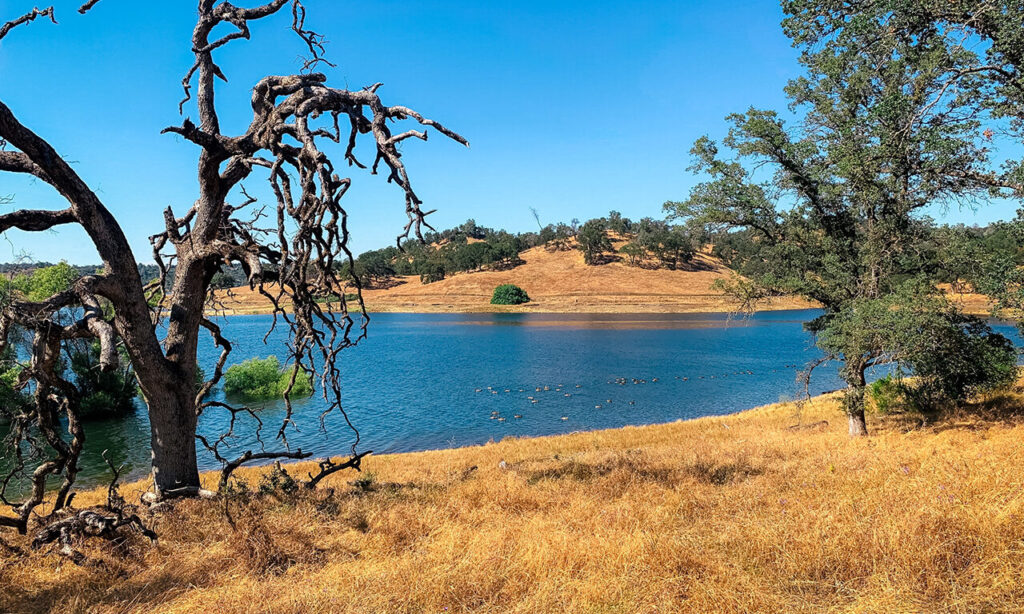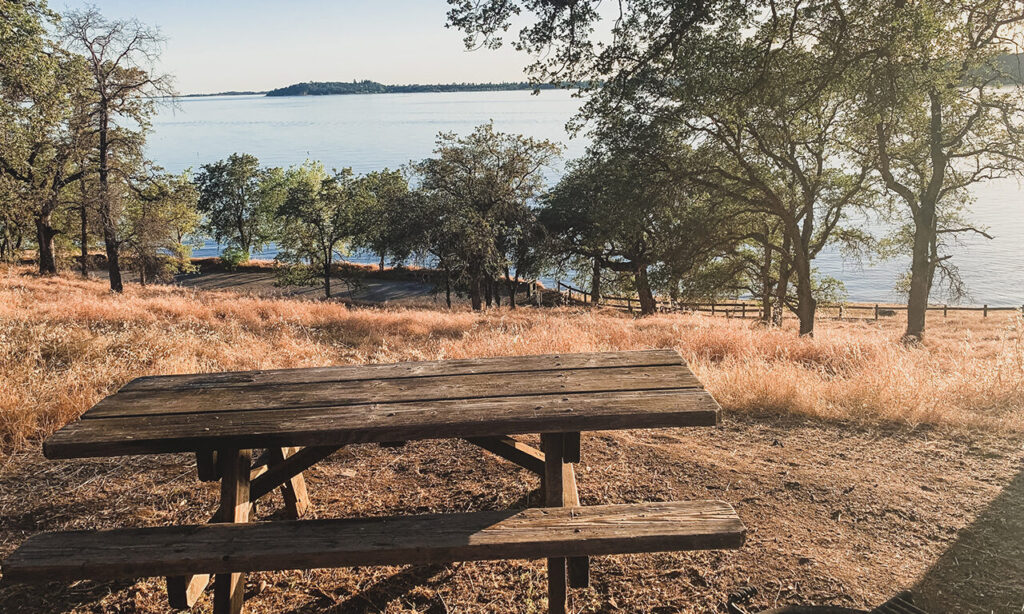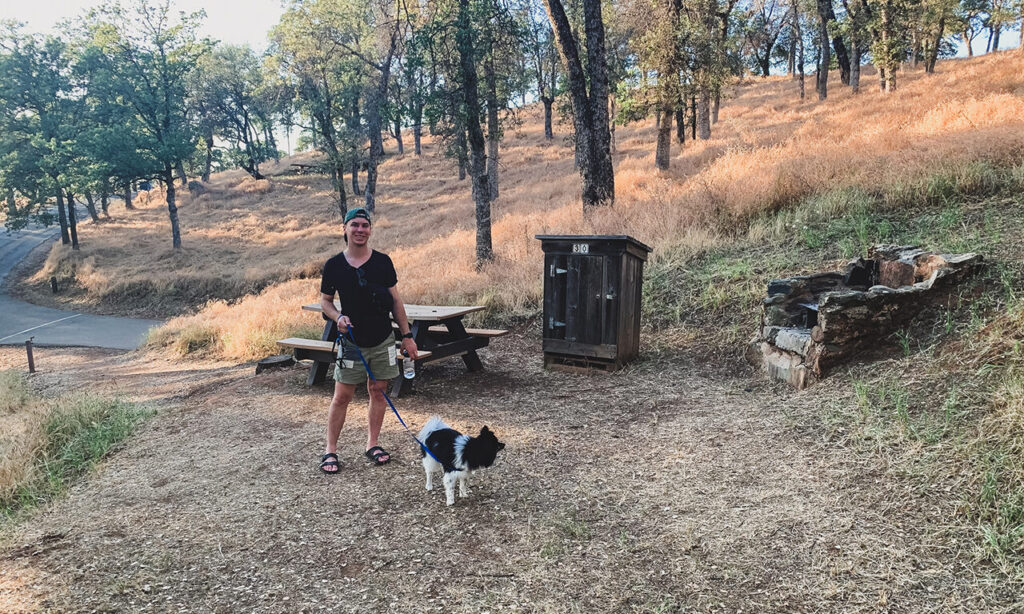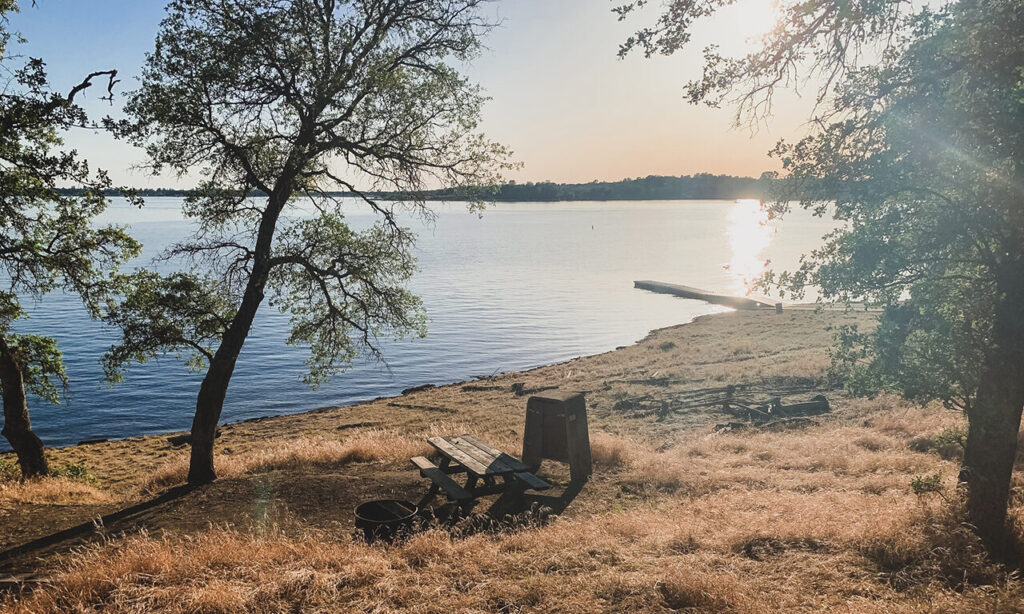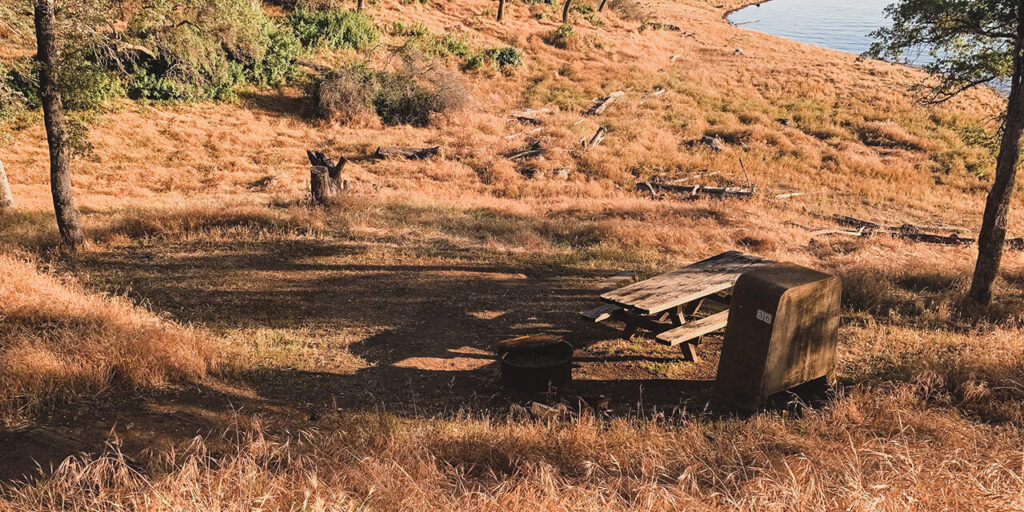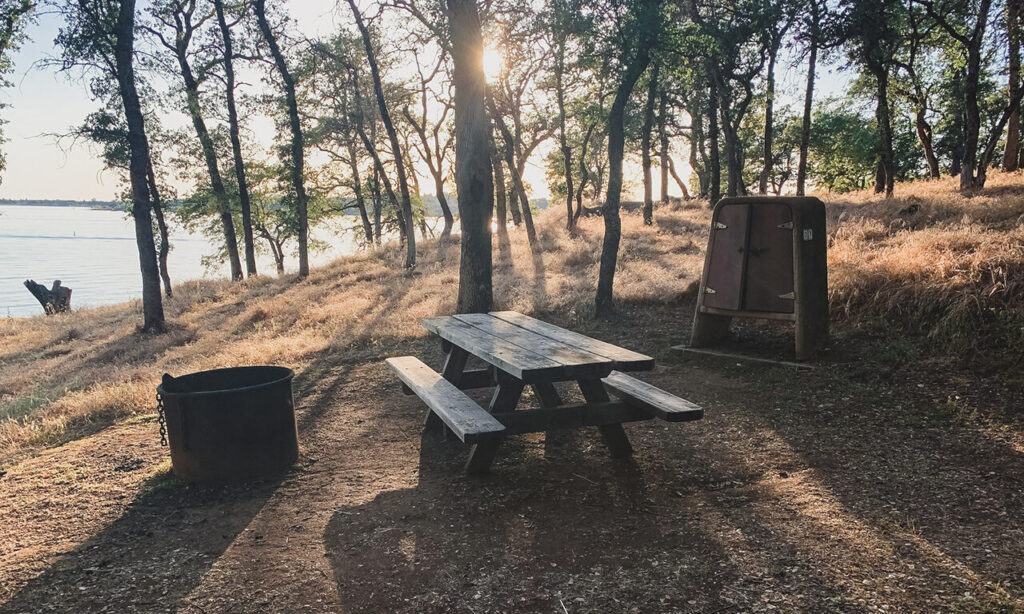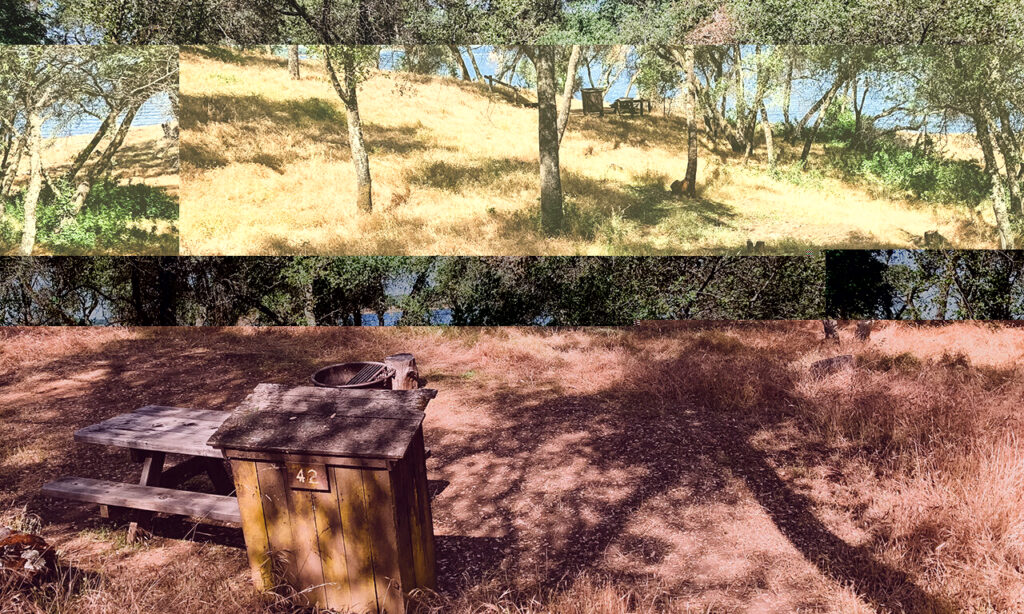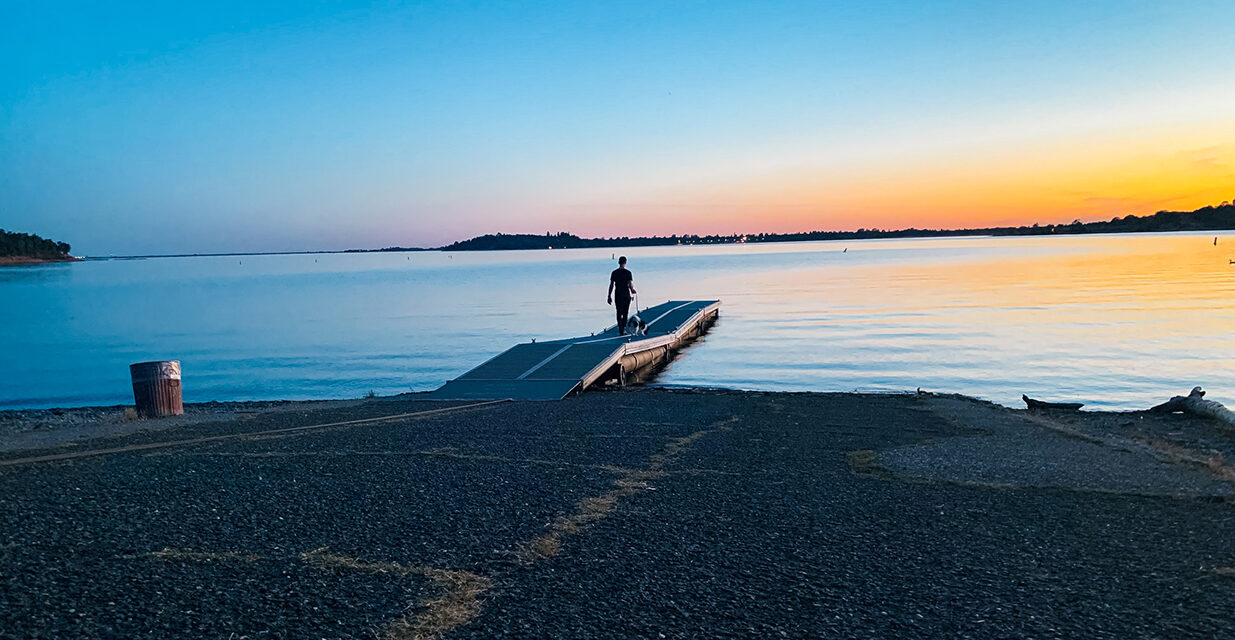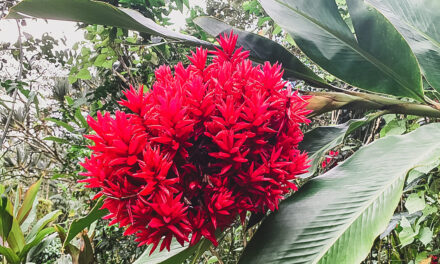The Peninsula Campground at Folsom Lake is a serene way to experience the landscape and beauty of local wildlife and nature.
Are you looking for an escape from the bustling city life of Sacramento? This place is for you.
I’m currently testing new outdoor camping equipment, tools, and supplies I’ve acquired. I needed a new, nearby escape to try everything out in a wild environment. While searching on Google, I saw the option of camping at the Peninsula Campground without first considering Folsom Lake as a place to overnight.
Miles outside the amenities of El Dorado Hills and surrounding communities, past the tiny village of Pilot Hill, down a nine-mile road, and you dead end at the Peninsula Campground with over 80 sites ready for you, your friends, and family to use and explore.
Table of Contents
Getting to the Peninsula Campground at Folsom Lake
The Peninsula Campground is located off Rattlesnake Bar Road in Pilot Hill and is situated on the eastern, remote peninsula of Folsom Lake.
El Dorado Hills Boulevard turns into Salmon Falls Road, and then you turn left at Pilot Hill (when you see the USPS Post Office) and head down Rattlesnake Bar Rd for 9.5 miles, where it ends at the campground.
Despite some switchbacks, narrow roads and steep cliffsides, the road itself into the camp is maintained without too many potholes or hazards and campsites can accommodate trailers up to 31 feet. At the park entrance is a gate and ranger station where you can check-in and pay fees if you didn’t reserve your campsite online in advance.
While driving through the campgrounds, we saw a coyote running across the road in the daylight, but didn’t have any encounters through the night.
Camping at the Peninsula Campground at Folsom Lake
The Peninsula Campground has a resident host and is staffed and managed by the California Department of Parks and Recreation.
We also chose to camp at Peninsula Campground at Folsom Lake because it’s dog friendly, as long as they stay on trails and only swim away from the major swim areas for humans at Beals Point, Negro Bar, and Granite Bay.
Folsom Lake SRA (State Recreation Area) maintains two campgrounds on Folsom Lake, including the Beal’s Point Campground and the Peninsula Campground. The campground of almost 100 sites is split into a northern group of sites (1-57) and a southern group of sites (58-96).
There’s a boat launch at the northern end of the Peninsula Campground and then another boat launch fully north of the campground off Oak Hill Road.
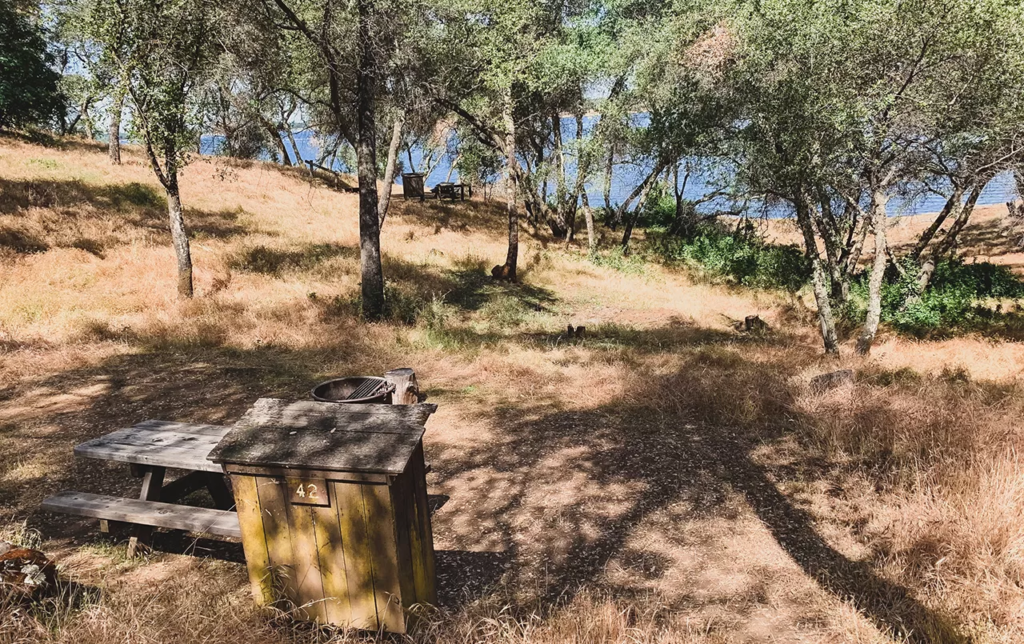
Site #42 at Peninsula Campground
We stayed at campsite #42 in the northern end of the campground, which is in a little pocketed ravine near the water, but set back a few campsites from the shore and campground boat launch.
It’s a bit of a walk to nearby built-in restrooms and only a short walk to Port-O-Potties by the boat launch.
At campsite #42, you park your car in a defined parking spot along the road, and then walk down some steps to your fire ring, picnic table and area for a tent, and not a site designed for trailers. There was a large trash bin up on the road that was helpful to be close to, but maybe it was a little too close, as it would smell near the entrance of our steps. A water spigot by the parking spots was a huge plus to have nearby but noted that site #42 had an older, wooden food box, while other sites featured newer, concrete versions of campsite food storage lockers.
We set up camp quickly, and then took a walk along the water on the Oaks Nature Trail, and dipped into the water at the two boat launches that are in the area of the Peninsula Campground at Folsom Lake.
On our next visit, I would choose another campground where it’s possible to park directly next to your campsite and one even closer to the water’s edge.
The Oaks Nature Trail at Folsom Lake
The start of the Oaks Nature Trail at Folsom Lake is at the north end of the campground boat launch parking lot.
The trail is 0.8 miles in length (1.6 miles out and back) and has compact gravel and a maintained trail that provides a safe space to take your dog for a walk and not come in contact with poison oak and cattails.
Despite the June weather and midday heat, the trail was still fun to explore had a few stream crossings and canopies of tree coverings in different areas. There were also informational displays every few hundred yards that talked of the importance of local oak trees, shared what animals live nearby, and gave insights into Native American food gathering and preparation.
It was quite a fun visit, and we had more camping on the horizon to be excited for — Hampshire Rocks Campground on the South Yuba River, North Fork Campground on the American River, and Alpine Meadow Campground in Truckee.
Don’t Forget to Hydrate!
Even anytime after April, the Folsom Lake area can get hot rapidly, with beating sun rays at midday.
If you’re visiting the Peninsula Campground, although water spigots are nearby, it’s important to remember to bring enough water for the duration of your stay, a way to filter water and hydrate continually throughout each day.
Also, put on your sunblock and re-apply regularly!
The History of Folsom: A City Steeped in California Gold
My relationship with Folsom, California, is layered with experiences that range from the adrenaline of assisting at the Folsom Lake Triathlon to the tranquility of cycling down the American River Bike Trail.
Folsom has always been more than just a dot on the map for me; it’s a retreat from Sacramento, a place of recreation and historical intrigue.
Whether camping at Peninsula Campground, exploring the Folsom City Zoo Sanctuary, or partaking in Old Town Folsom’s enchanting Christmas Tree lighting, this city never ceases to amaze.
Behind its modern charm lies a history as deep as the waters of Folsom Lake and as resonant as the chords of a Johnny Cash song echoing off the walls of its famous prison.
From Gold Rush to Urban Growth: The Foundation of Folsom
Folsom’s story begins with gold – the shimmering promise that lured seekers and set the stage for a city.
In the mid-1800s, gold fever swept through the area, and Joseph Libbey Folsom played a pivotal role in the city’s development. After purchasing land from the heirs of a grant, he envisioned a railway connecting the gold-rich foothills to the rest of California.
Sadly, Folsom passed away before seeing his dream come to fruition, but his vision lived on, and the city that took his name grew around the wealth brought forth from the earth and the innovation spurred by his ambition.
The Power of Water: Folsom’s Role in California’s Hydraulic History
Water has been a defining element of Folsom’s identity.
The city was instrumental in the development of hydroelectric power in California. The Folsom Powerhouse, once a marvel of engineering, began transmitting electricity to Sacramento in 1895, marking an era of progress and electrification.
Today, the Folsom Dam remains a critical source of water and power, a testament to the city’s ongoing legacy in harnessing natural resources.
Folsom Prison: A Penitentiary with a Cultural Footprint
Perhaps no other institution has brought as much notoriety and cultural significance to Folsom as its penitentiary.
Established in 1880, Folsom State Prison is one of the oldest correctional facilities in California.
It gained a place in the annals of pop culture when Johnny Cash performed and recorded a live album within its walls in 1968. The prison’s history is a complex orchestration of the state’s approach to reform and rehabilitation, and its presence in Folsom has profoundly shaped the city’s character.
Today’s Folsom: A Blend of Outdoor Splendor and Cultural Wealth
In modern times, Folsom balances its historical depth with the vibrancy of a city that loves the outdoors and cherishes its community.
Places like the Peninsula Campground and Beal’s Point Recreation Area serve as hubs for families and nature enthusiasts alike. The city’s commitment to trying to save and preserve green spaces and promoting outdoor activities is evident in every trail and park.
Q&A: Discovering the Layers of Folsom’s Past and Present
In my explorations of Folsom, I’ve often pondered how its past informs its present. Here are some questions that delve into that inquiry:
Q: What has been the impact of Folsom’s Gold Rush history on the city today?
A: The Gold Rush set the stage for Folsom’s early growth and continues to be celebrated in the city’s culture. It’s a legacy that adds a layer of historical tourism and shapes the community’s appreciation for its origins.
Q: How has Folsom adapted the heritage of the Folsom Powerhouse in contemporary times?
A: The Folsom Powerhouse now serves as a state historical park, providing visitors with insight into the evolution of electricity in California. The city honors this heritage through education and preservation, integrating it into its narrative of innovation.
Q: In what ways does Folsom Prison contribute to the city’s identity beyond Johnny Cash’s legacy?
A: Beyond the Cash legacy, Folsom Prison is integral to the city’s history, serving as a reminder of California’s penitentiary evolution. It’s a living history site that prompts discussions on criminal justice and rehabilitation.
Q: How do annual events like the Christmas Tree lighting in Old Town Folsom strengthen community bonds?
A: Annual events in Folsom, particularly the Christmas Tree lighting, bring the community together, fostering a sense of unity and continuity. They’re occasions that celebrate both the city’s rich history and its vibrant community spirit.
Q: Can you tell us about the significance of Mormon Island Wetlands State Park and the historical treasures revealed during low water levels at Folsom Lake?
A: Mormon Island Wetlands State Park is a fascinating locale within the Folsom Lake area, rich with historical artifacts from the Gold Rush era. During years of drought, when the water levels of Folsom Lake recede, the remnants of the once-submerged town of Mormon Island emerge as ghostly relics of a bygone epoch. It’s like stepping back in time as visitors can walk among the ruins and see tools, building foundations, and personal items that belonged to the 19th-century settlers. These occasional glimpses into the past offer a tangible connection to the early days of California’s history and underscore the impact of natural resource management on historical preservation.
Folsom’s Multifaceted Heritage
Folsom’s grand history and the life I’ve experienced within it continue to captivate me.
From the echoes of pickaxes in the gold mines to the hum of cyclists along the river trails, the city is a living history book, its pages filled with stories of innovation, culture, and community.
As I reminisce about my times at the triathlon or the zoo or those spent under the twinkling lights of a Christmas-celebrated Old Town, I’m reminded that Folsom is a city that not only honors its past but lives it every day.
And I am but one of many who have had the pleasure of being part of its unfolding story.
